Heating stoves: an overview of 4 popular options
Furnace heating has been known all over the world since time immemorial. It has not lost its relevance now. However, bulky traditional structures, which were built of stone, were replaced by rather compact and ergonomic brick and metal heating stoves. They can be purchased and easily installed with your own hands, without resorting to the services of a stove-setter and without undertaking large-scale construction work in your own home.
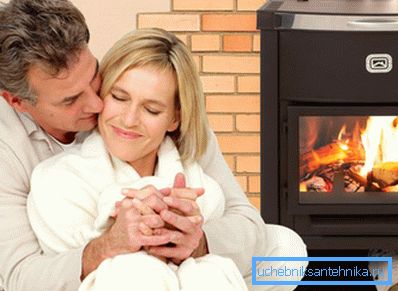
Equipment classification
According to the current construction standards, which are fixed by SNIP 41-01-2003, the room intended for people should be equipped with a heating system. The project of any home provides for the installation of a heating network.
The most common types of climate equipment:
- the boilers warming up the heat-transfer fluid;
- electric power heaters;
- solid fuel heating furnaces.
The latter option is most suitable for maintaining a comfortable microclimate in small-sized houses, for example, summer cottages, where you intend to come during the cold season only occasionally.

A simple heating stove occupies a minimum of space, its price is quite affordable for everyone, and the instruction manual is as simple as possible - put firewood in the furnace and do not forget to periodically clean the ash.
If you need something more, then in this case it will not be difficult to find a suitable model. There are various projects of heating furnaces that can satisfy the needs of even the most demanding customer.
The choice presented a huge number of different options:
- concrete, brick, stone, ceramic and metal;
- large, medium and small;
- with water or air circuit, and without it;
- bell and channel;
- combined models.
Tip! If you have a kitchen in the country, it will look great in a heating stove with a stove (and you can even have an oven). Such a device not only warms, but also feeds tasty food (naturally, not without the help of a good housewife).
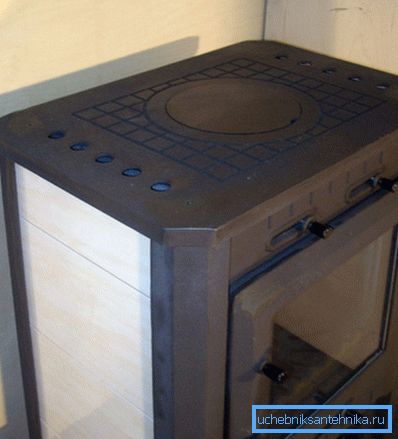
Consider the most common types of heating furnaces in more detail.
Varieties of devices
Option 1. Dutch
This category includes solid-fuel stoves that have specially equipped channels through which heated air passes, gradually releasing their heat to the air in the room through the walls of the heating device.

Smoke ducts can be installed both vertically and horizontally. The movement of heated gases in them is organized due to the difference in temperature and pressure inside and outside the stove, that is, using the phenomenon of so-called natural thrust.
When planning the installation of a Dutch oven for heating and choosing a suitable project, you should pay attention to such nuances:
- Heat transfer will be effective only if the cross-sectional area and the length of the smoke channels will be correctly calculated, and they are designed without installation errors. During the time that the smoke passes the path inside the furnace, the heat energy must be completely absorbed by the walls of the structure.
- Only an experienced craftsman professionally engaged in the construction of furnaces can make a detailed engineering calculation. Independently design a Dutch oven is very difficult.
- The same applies to the manufacturing process itself. If you do not have enough experience in construction, it’s impossible to construct a Dutch from brick, having laid out all the channels correctly. Most likely, the stove will not heat, but only smoke.

Note! Violation of the technology of the furnace can be dangerous to the health of the inhabitants of the house. So, from improperly constructed smoke channels, combustion products, deadly for a person, can penetrate into the room and lead to irreparable consequences - carbon monoxide poisoning.
Option 2. Channelless
In the manufacture of such systems channels are not used. Heat transfer occurs in the so-called caps - vertically located sinuses, where the accumulated smoke releases heat to the air in the room through the walls of the device.
As it cools, hot gases with combustion products descend, where it heats up again and flows into the next cap. After that, the smoke enters the chimney and is removed outside the dwelling.

Thus, better draft is provided and the room smoke is eliminated. If you decide to start making your own oven, this design will be the best choice.
Note! A large number of components are sold for the construction of two-bell furnaces in specialized stores: combustion chambers, cooking plates, grates, and so on. You only need to buy a brick, get a drawing of such a furnace and get to work. The result will not disappoint.
Option 3. With convection
Units that work on the principle of convection heat a room not by radiating thermal energy from a heated case or walls, but by heating the air and then mixing it due to the difference in temperature and density.
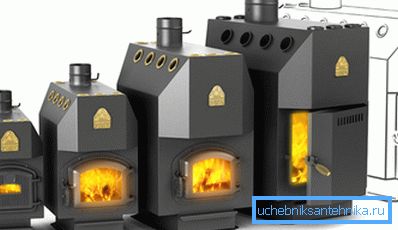
Widely known for their excellent consumer properties, heating convection ovens, produced by the engineering company Professor Butakov.
There are the following types of these units:
- Professor Butakov - air-heating boilers of various capacities (there are models “Student”, “Engineer” and “Docent”, which produce from 9 to 25 kW of heat and heat rooms with an area from 150 to 500 sq. Meters);
- Bagheera - heating devices equipped with a cooking surface for cooking;
- Grace - special heating units designed for installation in the steam rooms;
- Gymnazist - designed for heating and cooking, they are distinguished by economical consumption of solid fuel (Gymnazist-1, 2 and 3 models are on sale, differing from each other in power and size).

The general principle of operation of convection ovens is as follows:
- The body is made of thick sheets of refractory steel. The lower part of the furnace has grates, under which is located the ash chamber, which provides air intake to maintain the flame.
- Adjustment of the intensity of combustion and, accordingly, power, is done with the help of a damper that increases and decreases the volume of incoming air masses.
- Hollow steel pipes are laid through the firebox, which provide constant convection by sucking cold air from below and releasing it from above.
- Combustion products exit through the nozzle at the back of the stove, to which a chimney must be connected.
Simply put, this is a common heating furnace, which, thanks to air ducts, heats the air faster and has a higher efficiency.
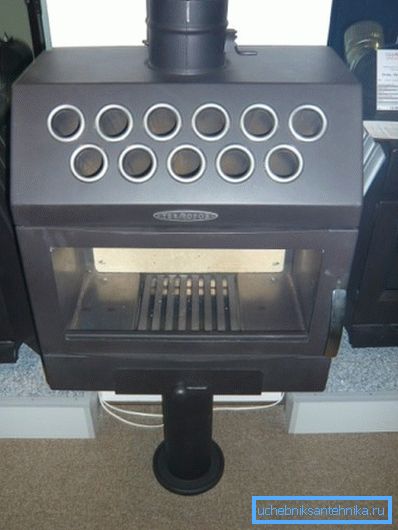
However, the engineers did not stop there.
There are other models on the market for convection solid-fuel furnaces that have certain features:
- Accordion Stoves production company Termofor - have an open combustion chamber protected by glass. Perform the role of the stove and the fireplace.
- Herma stoves, manufactured by the same company - they have both convection channels and a cap, thanks to which they give a maximum of thermal energy to the air in the rooms.
- Furnaces Vesuvius - premium heating units. This is the top model among the described heating equipment. Such devices not only heat the room, but also serve as its decoration.
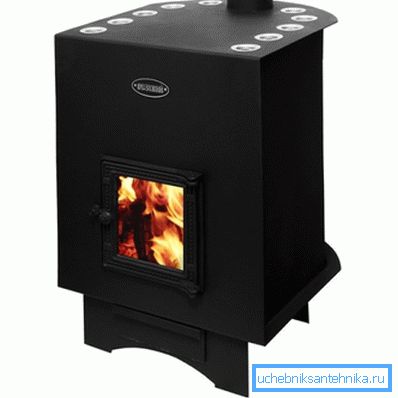
Despite the huge number of advantages, the convection solid-fuel stove is not without some disadvantages:
- The equipment has a small thermal inertia. After the fire is ignited, the room quickly heats up due to air circulation, but as soon as the firebox goes out, the furnace will no longer serve as a source of heat and will noticeably become cold in the room.
- If the instructions are not followed at the beginning of work, the device may overheat, and even cracks in the walls of the combustion chamber may appear.
- A solid-fuel convection oven cannot operate on a single fuel load for more than 5 hours. In addition, for fire safety purposes, it is not recommended to leave the operating unit unattended for a long time.
- The external walls of the device become very hot, therefore, when installing the furnace, it is necessary to strictly observe the fire safety regulations and the requirements of the SNiP.
- Some models of stoves have rather large dimensions and do not fit in kitchens. Therefore, cooking has to be done in other rooms of the house.
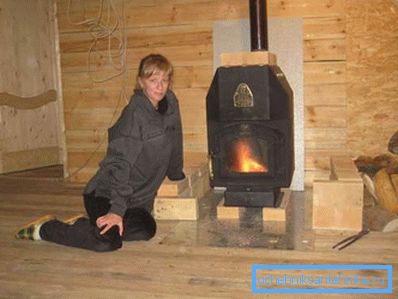
Option 4. Fireplaces
These devices are very often used for heating cottages and small houses. Despite the low efficiency, they are popular because of their appearance: the flame burns openly, giving the room comfort and coziness.
As for efficiency and power, it leaves much to be desired. The heat capacity of bricks used to construct fireplaces is very low. Therefore, thermal energy does not have time to be absorbed and flies "into the pipe."
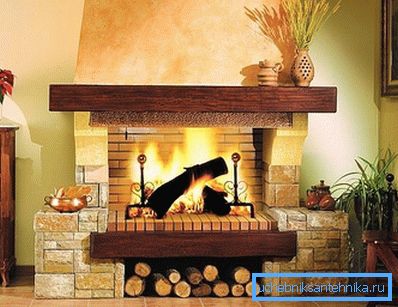
If you nevertheless decided to equip a fireplace, we recommend equipping it with a water or air heating circuit. This is a special design, mounted in a firebox, which warms up the air or water fired through it and provides all the rooms of the house with heat through a system of pipes or air ducts.
Whatever it was, the popularity of classic fireplaces and stoves remains quite high.
This is due to the following reasons:
- Units as easy to maintain.
- They work on the accumulative principle: the heat accumulated in the process of burning fuel is gradually given off to the air in the room and after the flame is attenuated.
- They differ in original appearance and, as a rule, serve as a central element of the interior of the room.
- Allow to cook food on an open fire, which gives dishes a refined taste and aroma.
Combined devices
In this category, the Umka-100 heating furnace is particularly notable among similar equipment. The unit is a long-burning furnace, equipped with a stove for cooking. The fuel can be either firewood or pellets. One bookmark lasts approximately 8 hours of operation of the device.
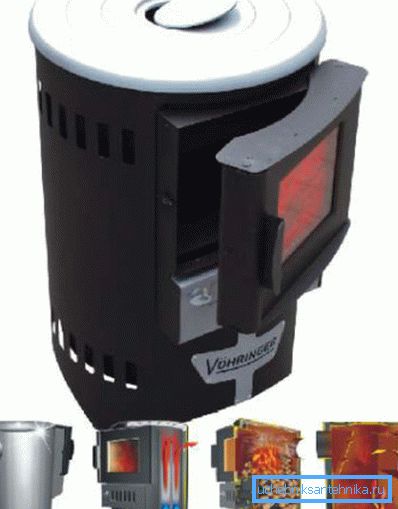
Another advantage is the ability to heat large rooms. In particular, the above-mentioned unit is able to provide warm room up to 100 square meters.
Moreover, the stove has a special circuit through which it is possible to arrange water heating in the country. So, having installed radiators in the neighboring rooms and connecting them with pipes to the stove, you can warm not only the room with a heater, but also the neighboring rooms.
Note! If you do not live at the dacha all the time, after the cessation of burning, the coolant in the pipes cools down and during freezing temperatures it can freeze, breaking pipes and radiators. Therefore, leaving after a country holiday, do not forget to drain the coolant with the help of a crane designed for this.
Conclusion
Modern heating furnaces, described above, allow to heat a dwelling rather effectively and quite economically. They have only one drawback - the need to constantly throw fuel into the combustion chamber. If this option does not suit you, pay attention to other ways to ensure a comfortable microclimate in the house.
For more information about the various options, see the video below.